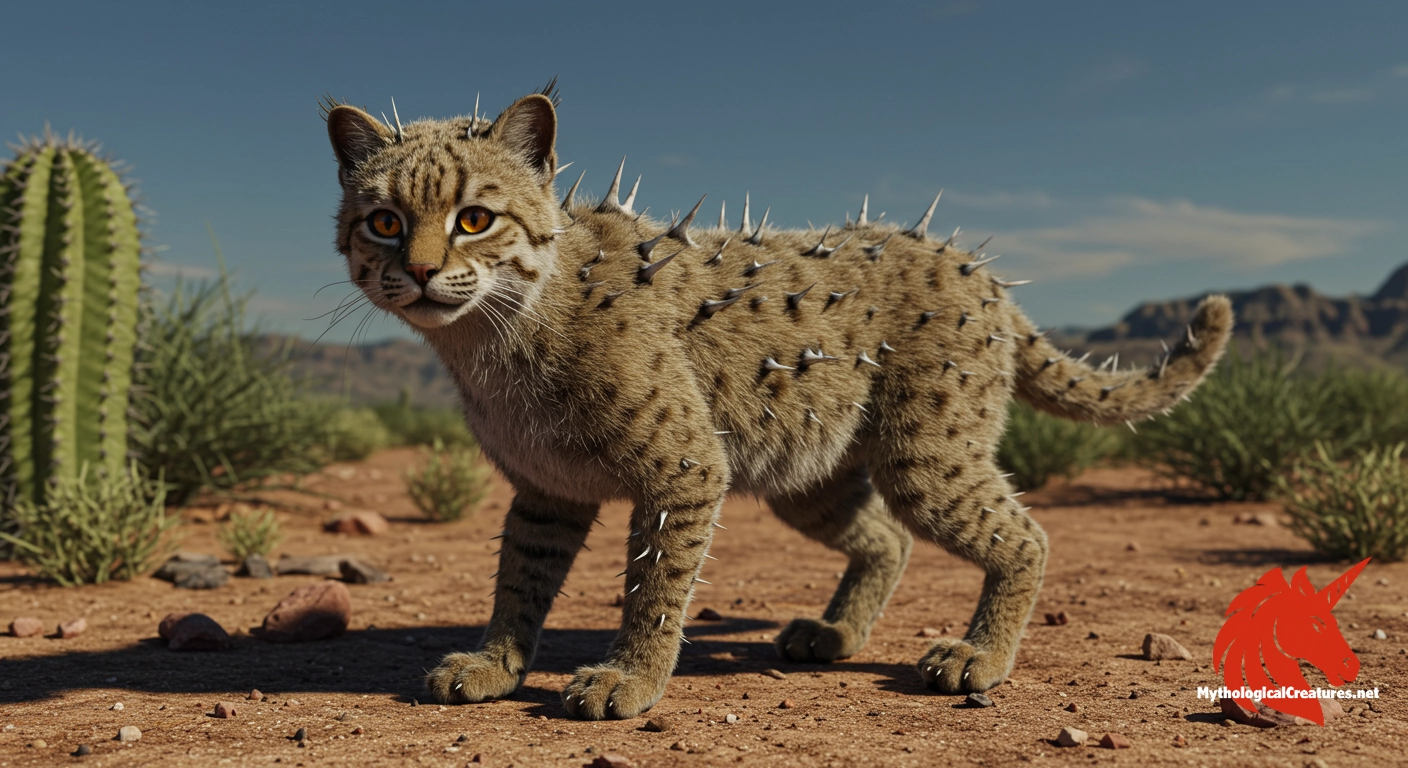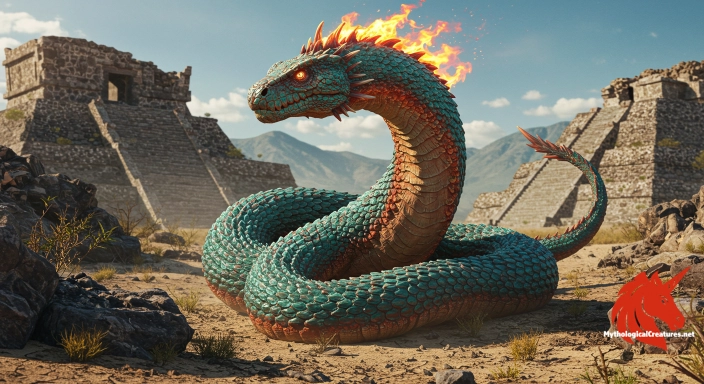Cactus cat: The cactus cat is a legendary fearsome critter from the American Southwest that resembles a bobcat with hair-like thorns and long spines.

Cactus cat
Cactus cat - Serves as a whimsical yet fearsome embodiment of the harsh desert environment, reflecting both natural ingenuity and mythical exaggeration.
Origins & First Encounters
The cactus cat emerges from the arid mists of the American Southwest, a figure both enigmatic and emblematic of the harsh desert landscape. Its legend is interwoven with the lore of early settlers and nomadic travellers who revered and feared the untamed wilderness. The creature’s origins are steeped in the oral traditions of frontier communities, with early attestations found in whispered campfire tales. It is depicted as a bobcat-like animal transformed by nature, its form uniquely adapted to the barrenness and mystique of the desert. Over time, the cactus cat has come to symbolise the unpredictable interplay between life and the stark environment. Its myth serves as a bridge between the natural world and human imagination, reflecting both admiration and caution. The narrative surrounding this creature underscores a deep cultural connection to the desert and its many hidden marvels. Local folklore has imbued it with qualities of both beauty and brutality, capturing the paradoxical spirit of the region. Ultimately, the cactus cat stands as a testament to how folklore transforms natural elements into enduring legends.
Source Texts & Tale Variants
Historical records of the cactus cat are primarily preserved through the vibrant tapestry of oral tradition and local storytelling rather than formal texts. Many early travellers and frontiersmen noted encounters with the creature, recording their experiences in diaries and letters that have since been passed down through generations. Early 20th-century compilations of American folklore present the cactus cat as a fearsome critter, attributing to it both mysterious abilities and a formidable presence. Variants of the story differ from one retelling to another, with some accounts emphasising its stealthy predation while others focus on its almost ritualistic behaviour with local cacti. In certain narratives, the creature is credited with using its spiny limbs to cut open cacti, allowing the plants’ juices to flow freely for later consumption. Other versions paint it as a guardian of the desert, whose nocturnal activities hint at a deeper, almost mystical role in the natural world. Despite these differences, the central motif of a bobcat-like animal integrated with thorn-like features persists across the spectrum of tales. Many folklore collections housed in regional libraries and oral history projects continue to celebrate these diverse accounts. This rich variety of sources reinforces the adaptability and enduring appeal of the cactus cat myth.
Form & Powers
The cactus cat possesses a striking and otherworldly appearance that blends the natural grace of a bobcat with the rugged elements of the desert flora. Its lithe body echoes the agile build of wild cats while being adorned with hair-like thorns that give it an almost impenetrable, armour-like quality. Long, menacing spines extend from its legs, designed not only for defence but also to interact dynamically with the surrounding vegetation. The creature’s tail is an elaborate, branching appendage that mirrors the structure of a cactus, reinforcing its unique botanical association. Its eyes are described as keen and reflective, suggesting a heightened awareness suited for nocturnal hunts. Fine details of its textured fur interlace natural fibres with thorny protrusions, creating an intricate mosaic of organic defences. Some accounts describe subtle variations in size, with a robust appearance in some legends and a more diminutive, elusive form in others. This blend of animalistic features with plant-like attributes results in a creature that is as formidable as it is fascinating. Its physical form stands as a natural marvel, embodying the harsh beauty and adaptive resilience of the desert environment.
Regional Faces
Across the vast expanse of the American Southwest, the cactus cat takes on a variety of compelling regional nuances. In arid desert communities, it is often seen as a mysterious inhabitant of rocky outcrops and sunbaked canyons, where its silhouette is part of the twilight lore. Hispanic cultural influences have blended with indigenous narratives, sometimes depicting the creature as a magical spirit with an almost shamanic presence. In regions bordering expansive cactus forests, locals have recounted sightings during the full moon, emphasising its spectral brightness against the dark desert night. Variations in its portrayal, such as a spectral predator in some areas and a benevolent, if dangerous, guardian in others, mirror the diverse environments of the Southwest. Mid-century ranchers and folk artists contributed distinct adaptations of its legend, imbuing the creature with attributes reflective of their unique experiences. Even within the same geographical area, subtle differences arise in the creature’s name, physical descriptions, and behavioural traits. These regional adaptations not only enrich the lore but also highlight how local landscapes and cultural histories shape mythic representations. The cactus cat’s mutable identity serves as a cultural mirror, reflecting the varied and rugged spirit of the American desert.
Cultural Parallels
The cactus cat exists within a broader framework of mythological hybrid creatures that challenge conventional classifications in folklore. Its amalgamation of feline agility and plant-like defences invites comparisons with other legendary hybrids, such as the Chupacabra of Latin American lore, known for its eerie predatory habits. Similar mythic beings can be found throughout various cultural narratives, where nature’s elements are personified through unusual creatures. For instance, some Native American legends also feature animal spirits that merge natural phenomena with physical traits, underscoring a universal human penchant for blending the animate with the inanimate. European folklore, too, has its share of hybrids that guard natural sanctuaries and exhibit extraordinary adaptations, resonating with the cactus cat’s dual role. These parallels suggest that the fusion of physical attributes from different kingdoms is a recurring motif in myth-making. Comparative studies reveal that such creatures often symbolise the borderlands between the known and the unknown, nature and the supernatural. The cactus cat, therefore, occupies a unique yet familiar space within the mythological landscape, echoing themes found across continents. Its story acts as a bridge between distinct cultural narratives that celebrate the melding of disparate natural elements.
Legacy & Modern Evolution
Over the decades, the legend of the cactus cat has evolved remarkably, reflecting changing cultural perceptions of the natural world. Initially conveyed through the rustic lore of desert settlers and cowboys, its image has been gradually reinterpreted through more modern artistic lenses. Early sketches and anecdotal accounts have given way to vibrant depictions in graphic novels, animations, and contemporary digital art. This evolution mirrors the increasing appreciation of the desert as a source of both stark beauty and mystery. In modern contexts, the cactus cat is often embraced as a quirky, iconoclastic symbol in local festivals and pop culture, representing both the spirit of adventure and the timeless allure of the unknown. Artists and storytellers frequently reimagine its form, highlighting its enigmatic blend of animal and plant in ways that attract new generations of enthusiasts. The creature now embodies a richer tapestry of meanings, from environmental resilience to the celebration of regional identity. Its enduring legacy is bolstered by academic interest and community initiatives that explore and celebrate Southwestern folklore. Today, the cactus cat continues to captivate imaginations as a dynamic reminder of how traditional legends adapt and thrive in the modern era.
Interesting Fact
One of the most intriguing aspects of the cactus cat legend is its clever method of extracting and consuming cactus juice, which underscores its unique adaptation and the inventive spirit of American Southwestern folklore.
Quick Creature Info
Origin:
Features:
Associations:
Our Mythic Legendary Rating:

Habitat:
Supernatural Powers:
Physical Attributes:
Abilities:
Behavior:
Weaknesses:
Lore:
Related Creatures, Tales or Lore
- JJackalope
- CChupacabra
- HHorned Toad
References
Discover Another Mythical Legend You May Not Have Heard Of?
Uncover the mysteries of ancient folklore and expand your knowledge of legendary beings from cultures around the world.
Dare to Meet the Xiuhcoatl....
Curated by the Mythological Creatures Team (rev. May 2025)
